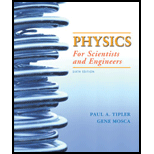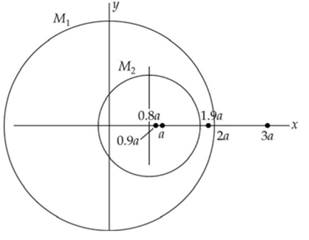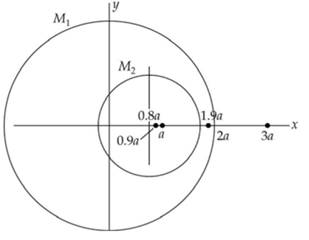
Concept explainers
(a)
To Calculate:The magnitude of gravitational force due to
(a)
Answer to Problem 74P
Explanation of Solution
Given data:
Radius of
Center has shifted,
Formula Used:
Gravitational field:
Where, G is the gravitational constant, m is the mass and r is the distance of the point where field is calculated.
The gravitational force is a force of attraction between any two bodies having mass and separated by a distance d . Mathematically, the gravitational force can be represented by:
Where, G is the gravitational constant, m and M are the masses and r is the distance between them.
Calculation:

The magnitude of force due to
Again, due to
Force,
Hence, net force
At
Conclusion:
Thus, the magnitude of gravitational force due to
(b)
The magnitude of gravitational force due to
(b)
Answer to Problem 74P
Explanation of Solution
Given data:
Radius of
Center has shifted,
Formula Used:
Gravitational field:
Where, G is the gravitational constant, m is the mass and r is the distance of the point where field is calculated.
The gravitational force is a force of attraction between any two bodies having mass and separated by a distance d . Mathematically, the gravitational force can be represented by:
Where, G is the gravitational constant, m and M are the masses and r is the distance between them.
Calculation:

The value of
Hence,
The value of
Hence, net force
Conclusion:
Thus, the magnitude of gravitational force due to
(c)
The magnitude of gravitational force due to
(c)
Answer to Problem 74P
Explanation of Solution
Given data:
Radius of
Center has shifted,
Formula Used:
Gravitational field:
Where, G is the gravitational constant, m is the mass and r is the distance of the point where field is calculated.
The gravitational force is a force of attraction between any two bodies having mass and separated by a distance d . Mathematically, the gravitational force can be represented by:
Where, G is the gravitational constant, m and M are the masses and r is the distance between them.
Calculation:

The value of
Again, the value of
So,
Hence, net force
Conclusion:
Thus, the magnitude of gravitational force due to
Want to see more full solutions like this?
Chapter 11 Solutions
Physics For Scientists And Engineers
- The gravitational force exerted on an astronaut on the Earths surface is 650 N directed downward. When she is in the space station in orbit around the Earth, is the gravitational force on her (a) larger, (b) exactly the same, (c) smaller, (d) nearly but not exactly zero, or (e) exactly zero?arrow_forwardEstimate the gravitational force between two sumo wrestlers, with masses 220 kg and 240 kg, when they are embraced and their centers are 1.2 m apart.arrow_forwardIf a spacecraft is headed for the outer solar system, it may require several gravitational slingshots with planets in the inner solar system. If a spacecraft undergoes a head-on slingshot with Venus as in Example 11.6, find the spacecrafts change in speed vS. Hint: Venuss orbital period is 1.94 107 s, and its average distance from the Sun is 1.08 1011 m.arrow_forward
- How far from the center of the Sun would the net gravitational force of Earth and the Sun on a spaceship be zero?arrow_forwardA point mass m is located a distance D from the nearest end of a thin rod of mass M and length L along the axis of the rod. Find the gravitational force exerted on the point mass by the rod.arrow_forwardSuppose the gravitational acceleration at the surface of a certain moon A of Jupiter is 2 m/s2. Moon B has twice the mass and twice the radius of moon A. What is the gravitational acceleration at its surface? Neglect the gravitational acceleration due to Jupiter, (a) 8 m/s2 (b) 4 m/s2 (c) 2 m/s2 (d) 1 m/s2 (e) 0.5 m/s2arrow_forward
- Calculate the effective gravitational field vector g at Earths surface at the poles and the equator. Take account of the difference in the equatorial (6378 km) and polar (6357 km) radius as well as the centrifugal force. How well does the result agree with the difference calculated with the result g = 9.780356[1 + 0.0052885 sin 2 0.0000059 sin2(2)]m/s2 where is the latitude?arrow_forwardA planet has two moons with identical mass. Moon 1 is in a circular orbit of radius r. Moon 2 is in a circular orbit of radius 2r. The magnitude of the gravitational force exerted by the planet on Moon 2 is (a) four times as large (b) twice as large (c) the same (d) half as large (e) one-fourth as large as the gravitational force exerted by the planet on Moon 1.arrow_forwardThe Sun has a mass of approximately 1.99 1030 kg. a. Given that the Earth is on average about 1.50 1011 m from the Sun, what is the magnitude of the Suns gravitational field at this distance? b. Sketch the magnitude of the gravitational field due to the Sun as a function of distance from the Sun. Indicate the Earths position on your graph. Assume the radius of the Sun is 7.00 108 m and begin the graph there. c. Given that the mass of the Earth is 5.97 1024 kg, what is the magnitude of the gravitational force on the Earth due to the Sun?arrow_forward
- Compute directly the gravitational force on a unit mass at a point exterior to a homogeneous sphere of matter.arrow_forwardIn introductory physics laboratories, a typicalCavendish balance for measuring the gravitational constant G uses lead spheres of masses1.68 kg and 14.4 g whose centers are separatedby 2.7 cm.Calculate the gravitational force betweenthese spheres, treating each as a point masslocated at the center of the sphere. Thevalue of the universal gravitational constantis 6.67259 × 10−11 N · m2/kg2.Answer in units of N.arrow_forward
 Principles of Physics: A Calculus-Based TextPhysicsISBN:9781133104261Author:Raymond A. Serway, John W. JewettPublisher:Cengage Learning
Principles of Physics: A Calculus-Based TextPhysicsISBN:9781133104261Author:Raymond A. Serway, John W. JewettPublisher:Cengage Learning Classical Dynamics of Particles and SystemsPhysicsISBN:9780534408961Author:Stephen T. Thornton, Jerry B. MarionPublisher:Cengage Learning
Classical Dynamics of Particles and SystemsPhysicsISBN:9780534408961Author:Stephen T. Thornton, Jerry B. MarionPublisher:Cengage Learning Glencoe Physics: Principles and Problems, Student...PhysicsISBN:9780078807213Author:Paul W. ZitzewitzPublisher:Glencoe/McGraw-Hill
Glencoe Physics: Principles and Problems, Student...PhysicsISBN:9780078807213Author:Paul W. ZitzewitzPublisher:Glencoe/McGraw-Hill University Physics Volume 1PhysicsISBN:9781938168277Author:William Moebs, Samuel J. Ling, Jeff SannyPublisher:OpenStax - Rice University
University Physics Volume 1PhysicsISBN:9781938168277Author:William Moebs, Samuel J. Ling, Jeff SannyPublisher:OpenStax - Rice University College PhysicsPhysicsISBN:9781305952300Author:Raymond A. Serway, Chris VuillePublisher:Cengage Learning
College PhysicsPhysicsISBN:9781305952300Author:Raymond A. Serway, Chris VuillePublisher:Cengage Learning Physics for Scientists and Engineers: Foundations...PhysicsISBN:9781133939146Author:Katz, Debora M.Publisher:Cengage Learning
Physics for Scientists and Engineers: Foundations...PhysicsISBN:9781133939146Author:Katz, Debora M.Publisher:Cengage Learning





